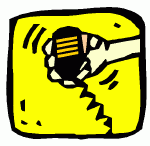Here comes Starlink!
 I’ve been reading a number of reports from the areas affected by the two major hurricanes (Helene and Milton). The North Carolina experience is particularly interesting because people have experienced the loss of communication and electrical service for several weeks. I can imagine this same thing happening in other parts of the country, including my area. As one example, read the on-the-ground disaster report from Thomas/K4SWL.
I’ve been reading a number of reports from the areas affected by the two major hurricanes (Helene and Milton). The North Carolina experience is particularly interesting because people have experienced the loss of communication and electrical service for several weeks. I can imagine this same thing happening in other parts of the country, including my area. As one example, read the on-the-ground disaster report from Thomas/K4SWL.
There are two important technology disruptions showing up in North Carolina: satellite-based internet (Starlink) and mobile-phone-to-satellite (SMS) text messaging. Starlink is having a significant impact during this incident, while mobile phone satellite messaging is still emerging. Steve N8GNJ has some worthy thoughts on these topics in Zero Retires 173. Although I have served in many ARES/RACES deployments over the years, I don’t consider myself an expert in this area. I’d appreciate comments from Emcomm folks who have spent more time thinking about this.

Types of Emergency Communication
Most relevant emergency comms lump into 1) short-range comms (< 5 miles) between family, friends, and neighbors. 2) medium-range comms (50 miles) to obtain information and resources. 3) long-range comms (beyond 50 miles) to connect with distant family, friends, and resources.
- Short-Range Comms: This is the type of communication that is well served by mobile phones, except when the mobile networks are down. This is happening a lot in North Carolina. Lightly licensed VHF/UHF radios such as FRS and GMRS can be used to replace your mobile phone. Think: wanting to call your neighbor 3 miles away to see if they are OK or can provide something you need. (I have a few FRS/GMRS radios in my stash to share with neighbors. See TIDRadio TD-H3) VHF/UHF ham radio is, of course, even better for this, except the parties involved need to be licensed. (OK, you can operate unlicensed in a true emergency, but that has other issues. See The Talisman Radio.)
- Medium-Range Comms: This is a great fit for VHF/UHF ham radio using repeaters or highly-capable base stations. GMRS repeaters can also serve this need. These communications will typically be about situational awareness and resource availability in the surrounding area. For example, someone on the local ham repeater may know whether the highway is open to the place you want to drive.
- Long-Range Comms: Historically, this has been done by HF ham radio and a lot of emergency traffic is still handled this way. The shift that is happening is that setting up a Starlink earth station feeding a local WiFi network can help a lot of people in a very effective manner. Compare passing a formal piece of health-and-welfare traffic via ham radio to letting a non-licensed person simply get Wi-Fi access to their email or text messaging app. Hams are doing this, but many unlicensed techie folks have set up these systems and freely shared them with the public.
Mobile Satellite Messaging
Various providers now offer a basic text messaging capability using smartphones talking to satellites. Today, this capability is often limited to emergencies (“SOS”), and it is relatively slow. With time, this capability will certainly improve, and basic satellite texting will become ubiquitous on smartphones. This will be great for checking in with distant friends and families, but it may not be that useful for Short Range and Medium Range comms. Someday, it might include voice comms, but in the near term, it is probably just text-based.
Evan K2EJT provides some useful tips based on his experience here in this video. However, he doesn’t address the Starlink capability.
Summary
While much of the public appreciates the usefulness of ham radio during emergencies, I am already hearing questions like “Doesn’t Starlink cover this need?” My view is that Starlink (and similar commercial sats) is very useful and will play an important emcomm role, but it does not cover all of the communication needs during incidents such as hurricanes, blizzards, wildfires, earthquakes, etc. Similarly, Mobile Satellite communications will be a great help during emergencies in the future but will probably not cover every need. Emcomm folks (ARES and RACES) will need to adapt their approach to take this into account.
Those are my thoughts. What do you think?
73 Bob K0NR













 A few weeks back, I was
A few weeks back, I was 

 We’ve been looking at optimizing the performance of the D-STAR repeater here in Monument (
We’ve been looking at optimizing the performance of the D-STAR repeater here in Monument (
